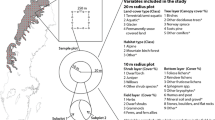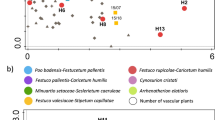Abstract
This study was conducted in the Swedish sub-Arctic, near Abisko, in order to assess the direction and scale of possible vegetation changes in the alpine–birch forest ecotone. We have re-surveyed shrub, tree and vegetation data at 549 plots grouped into 61 clusters. The plots were originally surveyed in 1997 and re-surveyed in 2010. Our study is unique for the area as we have quantitatively estimated a 19% increase in tree biomass mainly within the existing birch forest. We also found significant increases in the cover of two vegetation types—“birch forest-heath with mosses” and “meadow with low herbs”, while the cover of snowbed vegetation decreased significantly. The vegetation changes might be caused by climate, herbivory and past human impact but irrespective of the causes, the observed transition of the vegetation will have substantial effects on the mountain ecosystems.



Similar content being viewed by others
References
Anisimov, O.A., D.G. Vaughan, T.V. Callaghan, C. Furgal, H. Marchant, T.D. Prowse, H. Vilhjálmsson, and J.E. Walsh. 2007. Polar regions (Arctic and Antarctic). In Climate change 2007: Impacts, adaptation and vulnerability. Contribution of working group II to the fourth assessment report of the intergovernmental panel on climate change, ed. M.L. Parry, O.F. Canziani, J.P. Palutikof, C.E. Hanson, and P.J. van der Linden. Cambridge: Cambridge University Press.
Babst, F., J. Esper, and E. Parlow. 2010. Landsat TM/ETM plus and tree-ring based assessment of spatiotemporal patterns of the autumnal moth (Epirrita autumnata) in northernmost Fennoscandia. Remote Sensing of Environment 114: 637–646.
Björk, R.G., and U. Molau. 2007. Ecology of alpine snowbeds and the impact of global change. Arctic, Antarctic, and Alpine Research 39: 34–43.
Cairns, D.M., and J. Moen. 2004. Herbivory influences tree lines. Journal of Ecology 92: 1019–1024.
Callaghan, T.V., F. Bergholm, T.R. Christensen, C. Jonasson, U. Kokfelt, and M. Johansson. 2010. A new climate era in the sub-Arctic: Accelerating climate changes and multiple impacts. Geophysical Research Letters 37. doi:10.1029/2009GL042064.
Callaghan, T.V., L.O. Björn, T. Chapin, Y. Chernov, T.R. Christensen, B. Huntley, R.A. Ims, M. Johansson, et al. 2005. Arctic tundra and polar desert ecosystem. In Arctic climate impact assessment (ACIA), ed. A.C. IA, 243–352. Cambridge: Cambridge University Press.
Chapin III, F.S. 1983. Direct and indirect effects of temperature on Arctic plants. Polar Biology 2: 47–52.
Chapin III, F.S., M. Berman, T.V. Callaghan, P. Convey, A.-S. Crepin, K. Danell, H. Ducklow, B. Forbes, et al. 2005. Polar Systems. In Ecosystems and human well-being: Current state and trends, vol. 1, ed. R. Hassan, R. Scholes, and N. Ash, 717–743. Washington: Island Press.
Christensen, T.R., T. Johansson, M. Olsrud, L. Ström, A. Lindroth, M. Mastepanov, N. Malmer, T. Friborg, et al. 2007. A catchment-scale carbon and green house gas budget of a subarctic landscape. Philosophical Transactions of the Royal Society A 365: 1643–1656.
Dahlberg, U., T.W. Berge, H. Petersson, and C.P. Vencatasawmy. 2004. Modelling biomass and leaf area index in a sub-arctic Scandinavian mountain area. Scandinavian Journal of Forest Research 19: 60–71.
Danby, R.K., and D.S. Hik. 2007. Variability, contingency and rapid change in recent subarctic alpine tree line dynamics. Journal of Ecology 95: 352–363.
Edenius, L., C.P. Vencatasawmy, P. Sandström, and U. Dahlberg. 2003. Combining satellite imagery and ancillary data to map snowbed vegetation important to reindeer Rangifer tarandus. Arctic, Antarctic, and Alpine Research 35: 150–157.
Emanuelsson, U. 1987. Human influence on vegetation in the Torneträsk area during the last three centuries. Ecological Bulletins 30: 95–111.
Forbes, B.C., M.M. Fauria, and P. Zetterberg. 2010. Russian Arctic warming and ‘greening’ are closely tracked by tundra shrub willows. Global Change Biology 16: 1542–1554.
Galen, C., and M.L. Stanton. 1995. Response of snowbed plant species to changes in growing-season length. Ecology 76: 1546–1557.
Grabherr, G., M. Gottfried, and H. Pauli. 1994. Climate effects on mountain plants. Nature 369: 448.
Grubb, H. 2008. Torneträsk tree-ring width and density AD 500–2004: A test of climatic sensitivity and a new 1500-year reconstruction of north Fennoscandian summers. Climate Dynamics 31: 843–857.
Hallinger, M., M. Manthey, and M. Wilmking. 2010. Establishing a missing link: warm summers and winter snow cover promote shrub expansion into alpine tundra in Scandinavia. New Phytologist 186: 890–899.
Hartley, A.E., C. Neil, J.M. Melillo, R. Crabtree, and F.P. Bowles. 1999. Plant performance and soil nitrogen mineralization in response to simulated climate change in subarctic dwarf shrub heath. Oikos 86: 331–343.
Heegaard, H., and V. Vandvik. 2004. Climate change affects the outcome of competitive interactions: An application of principal response curves. Oecologia 139: 459–466.
Heegard, E. 2002. A model of alpine species distribution in relation to snowmelt time and altitude. Journal of Vegetation Science 13: 493–504.
Heliasz, M., T. Johansson, A. Lindroth, M. Mölder, M. Mastepanov, T. Friborg, T.V. Callaghan, and T.R. Christensen. 2011. Quantification of C uptake in subarctic birch forest after setback by an extreme insect outbreak. Geophysical Research Letters 38: L01704. doi:10.1029/2010GL044733.
Hentton, H., and H. Wallgren. 2001. Rodent dynamics and communities in the birch forest zone of northern Fennoscandia. In Nordic Mountain birch ecosystems. Man and the biosphere series, ed. F.E. Wielgolaski, Vol 27, 261–278. New York: The Parthenon Publishing Group.
Ihaka, R., and R. Gentleman. 1996. R: A statistical language for data analysis and graphics. Journal of Computational and Graphical Statistics 5: 299–314.
Kammer, P.M., C. Schöb, and P. Choler. 2007. Increasing species richness on mountain summits: upward migration due to anthropogenic climate change or re-colonization? Journal of Vegetation Science 18: 301–306.
Karlsson, H., G. Hörnberg, G. Hannon, and E.-M. Nordström. 2007. Long-term vegetation changes in the northern Scandinavian forest limit: A human impact-climate synergy? The Holocene 17: 37–49.
Karlsson, P.S., and M. Weih. 2003. Long-term patterns of leaf, shoot and wood production after insect herbivory in the Mountain Birch. Functional Ecology 17: 841–850.
Karlsson, P.S., M. Weih, and C. Borg. 2005. Mountain birch growth in relation to climate and herbivores. In Plant Ecology, Herbivory, and Human Impact in Nordic Mountain Birch Forests, ed. F.E. Wielgolaski, 71–86. Berlin: Springer-Verlag.
Kattsov, V.M., E. Källén, H. Cattle, J. Christensen, I. Hanssen-Bauer, T. Jóhannesen, I. Karol, J. Räisänen, et al. 2005. Future climate change: Modeling and scenarios for the arctic. In Arctic climate impact assessment (ACIA), ed. A.C. IA, 243–352. Cambridge: Cambridge University Press.
Kohler, J., O. Brandt, M. Johansson, and T. Callaghan. 2006. A long-term Arctic snow depth record from Abisko, northern Sweden, 1913–2004. Polar Research 25: 91–113.
Kullman, L. 2002. Rapid recent range-margin rise of tree and shrub species in the Swedish Scandes. Journal of Ecology 90: 68–77.
Liberkartor. 1981. Vegetationskarta över de Svenska fjällen. Kartblad nr2, Abisko. Stockholm: LiberKartor. [Vegetation map over the Swedish mountains; in Swedish, vegetation class names in English].
McBean, G., G. Alekseev, D. Chen, E. Førland, J. Fyfe, P. Groisman, R. King, H. Melling, et al. 2005. Arctic climate—past and present. In Arctic climate impact assessment (ACIA), ed. A.C. IA, 21–60. Cambridge: Cambridge University Press.
Moen, J., K. Aune, L. Edenius, and A. Angerbjörn. 2004. Potential effects of climate change on treeline position in the Swedish mountains. Ecology and Society 9: 16.
Olofsson, J., L. Oksanen, T. Callaghan, E.P. Hulme, T. Oksanen, and O. Suominen. 2009. Herbivores inhibit climate-driven shrub expansion on the tundra. Global Change Biology 15: 2681–2693.
Rafstedt, T. (ed.) 1985. Vegetation of the Swedish mountain area, Norrbottens county. A survey on the basis of vegetation mapping and assessment of natural values. Solna: Statens Naturvårdsverk.
Rundqvist, S., H. Hedenås, A. Sandström, U. Emanuelsson, H. Eriksson, C. Jonasson, and T.V. Callaghan. 2011. Tree and shrub expansion over the past 34 years at the tree-line near Abisko, Sweden. Ambio. doi:10.1007/s13280-011-0174-0.
Sandvik, S.M., E. Heegaard, R. Elven, and V. Vandvik. 2004. Response of alpine snowbed vegetation to long-term experimental warming. Ecoscience 11: 150–159.
Scherrer, D., and C. Körner. 2011. Topographically controlled thermal-habitat differentiation buffers alpine plant diversity against climate warming. Journal of Biogeography 38: 406–416.
Sonesson, M., and J. Hoogsteger. 1983. Recent treeline dynamics (Betula pubescens Ehrh. ssp. tortuosa (Ledeb.) Nyman) in northern Sweden. Nordicana 47: 47–54.
Sturm, M., C. Racine, and K. Tape. 2001. Climate change—increasing shrub abundance in the Arctic. Nature 411: 546–547.
Sundqvist, M.K., R.G. Björk, and U. Molau. 2008. Establishment of boreal forest species in alpine dwarf-shrub heath in subarctic Sweden Mountain birch advance into alpine tundra. Plant Ecology & Diversity 1: 67–75.
Tape, K., M. Sturm, and C. Racine. 2006. The evidence for shrub expansion in Northern Alaska and the Pan-Arctic. Global Change Biology 12: 686–702.
Tenow, O., H. Bylund, and B. Holmgren. 2001. Impact on mountain birch forests in the past and the future of outbreaks of two geometrid insects. In Nordic Mountain birch ecosystems. Man and the biosphere series, ed. F.E. Wielgolaski, Vol. 27, 223–239. New York: The Parthenon Publishing Group.
Tømmervik, H., B. Johansen, J.Å. Riseth, S.R. Karlsen, B. Solberg, and K.A. Høgda. 2009. Above ground biomass changes in the mountain birch forests and mountain heaths of Finnmarksvidda, northern Norway, in the period 1957–2006. Forest Ecology and Management 257: 244–257.
Van Bogaert, R., K. Haneca, J. Hoogesteger, C. Jonasson, M. De Dapper, and T.V. Callaghan. 2011. A century of tree line changes in sub-Arctic Sweden show local and regional variability and only a minor role of 20th century climate warming. Journal of Biogeography. doi:10.1111/j.1365-2699.2010.02453.x.
Van Bogaert, R., C. Jonasson, M. De Dapper, and T.V. Callaghan. 2009. Competitive interaction between aspen and birch moderated by invertebrate and vertebrate herbivores and climate warming. Plant Ecology and Diversity 2: 221–232.
Virtanen, R. 2000. Effects of grazing on above-ground biomass on a mountain snowbed, NW Finland. Oikos 90: 295–300.
Walker, M.D., C.H. Wahren, R.D. Hollister, G.H.R. Henry, L.E. Ahlquist, J.M. Alatalo, M.S. Bret-Harte, M.P. Calef, et al. 2006. Plant community response to experimental warming across the tundra biome. Proceedings of the National Academy of Sciences 103: 1342–1346.
Weih, M., and P.S. Karlsson. 1997. Growth and nitrogen utilization in seedlings of mountain birch (Betula pubescens ssp. tortuosa) as related to plant nitrogen status and temperature: A two-year study. Écoscience 4: 365–373.
Wilson, S.D., and C. Nilsson. 2009. Arctic and alpine vegetation change over years. Global Change Biology 15: 1676–1684.
Acknowledgments
We sincerely thank Mats Jonasson, Patrik Åström, and Anders Petterson for conducting the field work, and the staff of the Swedish National Forest Inventory and Abisko Arctic Scientific Research Station for their support. We also thank Craig E. Tweedie and an anonymous reviewer for their valuable comments. The project was mainly funded by Swedish Environmental Protection Agency. Funding was also obtained from IPY project No 512 “Back to the Future”, Formas grant 214-2008-188.
Author information
Authors and Affiliations
Corresponding author
Rights and permissions
About this article
Cite this article
Hedenås, H., Olsson, H., Jonasson, C. et al. Changes in Tree Growth, Biomass and Vegetation Over a 13-Year Period in the Swedish Sub-Arctic. AMBIO 40, 672–682 (2011). https://doi.org/10.1007/s13280-011-0173-1
Published:
Issue Date:
DOI: https://doi.org/10.1007/s13280-011-0173-1




